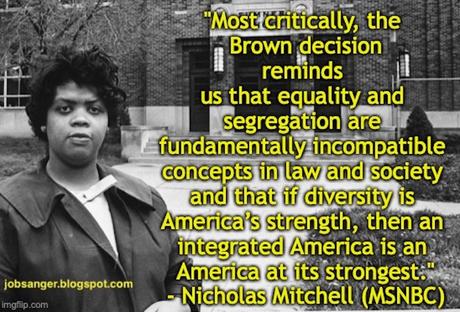
The following is part of an article by Assistant Professor Nicholas Mitchell (University of Kansas) at MSNBC.com:
Linda Carol Brown, because she was Black, was made to walk past the all-white Sumner Elementary School to catch the bus to Monroe Elementary School, which was all Black.
But one of the hard facts that we must confront is that in the 70 years since Brown, the social and legal resistance to desegregation has never stopped. Segregationists employed a variety of tactics whose legacies have made American education an enterprise that’s endemically segregated by race and classtoday. Whether it’s the all-white private schools that were created in response to Brown, the white flight out of cities that was inspired by the same ruling, a subsequent Supreme Court ruling that there’s no right to an equally funded education, or the growing popularity of publicly funded vouchers for private schools, the promise of the 1954 decision hasn’t translated into reality for today’s Linda Carol Browns.
According to a 2022 report from the Government Accountability Office, “During the 2020-21 school year, more than a third of students (about 18.5 million) attended schools where 75% or more students were of a single race or ethnicity” and “14 percent of students attended schools where 90 percent or more of the students were of a single race/ethnicity.”. . .
The two biggest blows to Brown came in 1973 and 1974 with the Supreme Court rulings in San Antonio ISD v. Rodriguez and Milliken v. Bradley, respectively. In the first case, parents in the majority Mexican American Edgewood school district said funding schools using the local tax base denied their children the right to an equal education, but the Supreme Court held that there was no constitutional right to an equally funded education. In the next year’s Milliken case, the court upheld an absurd distinction between segregation by law and segregation by custom (de jure versus de facto segregation) as if segregation by custom were not created by law.
Justice William O. Douglas pointed out that absurdity in his dissenting opinion. “There is, so far as the school cases go, no constitutional difference between de facto and de jure segregation,” he wrote. “Restrictive covenants maintained by state action or inaction build black ghettos. It is state action when public funds are dispensed by housing agencies to build racial ghettos.”. . .
When we recognize that America is still having the same debate over desegregation that began on May 17, 1954, then today’s culture war fights — over the consideration of race as part of holistic admissions at highly selective schools, the inclusion of non-white history and literature into the standard curriculum, and the rise of charter schools — become more understandable.
Some argue that the Brown decision is irrelevant today or that it failed. I disagree. For all the scheming of men and women dedicated to rolling back the tide of integration, they have only been successful in slowing it. Jim Crow’s insane racial caste system was overthrown in an attempt to create a multiracial democracy in a world where none had previously existed. This grand project is a work in progress, and the setbacks have rocked the country to its foundations because the clash between integration and segregation has existed as long as the country has.
Most critically, the Brown decision reminds us that equality and segregation are fundamentally incompatible concepts in law and society and that if diversity is America’s strength, then an integrated America is an America at its strongest.

